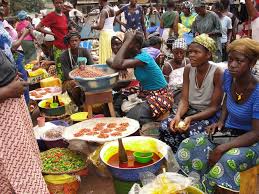EXPLAINER: Prices are going up but inflation rate is dropping — what’s the magic?
According to the report, the consumer price index (CPI), which measures the rate of change in prices of goods and services, declined for the seventh consecutive time to 15.99 percent in October.
The figure is 1.76 percent points higher than the 14.23 percent recorded in October 2020.
“From where does the National Bureau of Statistics get their data? Is it from the same market and society we patronize and live in?” Godson Udeagha, a Facebook user, quizzed the recent inflation report.
But how exactly is the inflation rate calculated? Is NBS report a true reflection of the current market reality?
NBS CPI METHODOLOGY
In discussing the 15.99 percent inflation rate for October, we should first look closely at the methodology used by the bureau to arrive at their conclusion.
According to NBS, the CPI measures the average change over time in the prices of goods and services consumed by people for day-to-day living. The bureau said it employs the services of 10,534 informants spread across the country to provide prices of goods and services monthly.
The market items used to arrive at their conclusion currently comprise 740 goods and services regularly priced.
The first stage in the calculation of the CPI is the collection of prices on each item (740 goods and services) from outlets in each sector (rural or urban) for each state. Prices are then averaged for each item per sector across the state.
The next step, according to the NBS, is to use the average price to calculate the basic index for each commodity, that’s the current year price of each commodity is compared with a base year’s price to obtain a relative price.
The recent inflation report shows that the country’s composite Consumer Price Index dropped by 15.99 percent year-on-year to 399.9 index points in October 2021 from 344.7 points recorded in October 2020.
Meanwhile, in September 2021, the inflation rate was 16.63 percent year-on-year to 396 index points.
REDUCTION IN RATES NOT DROP IN PRICES
Here is the bone of contention, if inflation dropped to 15.99 percent which is the lowest in the last ten months, why are things still expensive?
Assuming the price of an egg was N100 in August, N200 in September, and N300 in October. This means that the price keeps rising — but the rate of increase dropped.
In simple terms, there was a 100 percent increase between August and September. In October, the rate dropped to 50 percent.
This is q basic analysis of the movement of the inflation rate within a period.
Using the current inflation report, the NBS said the rate at which prices of goods and services increase has dropped by 15.99 percent in October compared to October 2020. That does not mean that prices are not rising, but the purchasing power of Nigerians continues to grow weaker.
Also, on a month-on-month basis, inflation was 1.15 percent in September with an index of 396 and dropped to 0.98 percent in October with an index of 399.9. It clearly shows that there was an increase in the prices of goods and services, but the rate of increase has dropped.
EXPERT EXPRESSES SAME POSITION
An economist who preferred anonymity told TheCable that people have different perspectives on inflation figures — but it does not mean what NBS is saying is wrong.
He explained that everyone in Nigeria has a different inflation rate because consumptions are different.
“So if what Mr A consumes has gone up by 20 percent, and that of Mr B went up by 15 percent, it means both Mr A and B might have a different opinion of the inflation rate,” he said.
“Hence why we have a national statistical body responsible to aggregate or try to find a balance between what everyone consumes using a particular basket of goods and services.
“Another example is this, imagine that in February you bought a bag of rice at N20,000 instead of the N15,000 it sold at in January (5.7% increase), but in March you bought the same bag of rice at 25,500 (1.6% increase), and in April you bought the same bag for (30,700) which is a 0.7% increase.
“You will notice that, although the price of a bag of rice has increased between January and April but the rate at which it increased has gone down. That’s what NBS is saying has reduced for the seventh consecutive month and lowest in 2021.”


